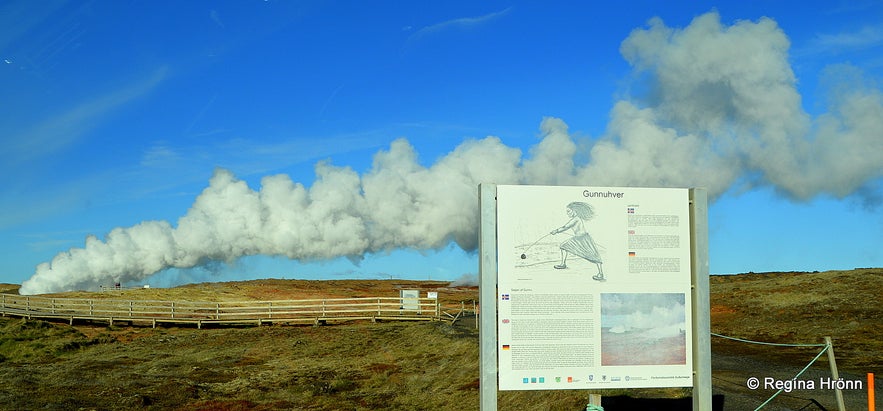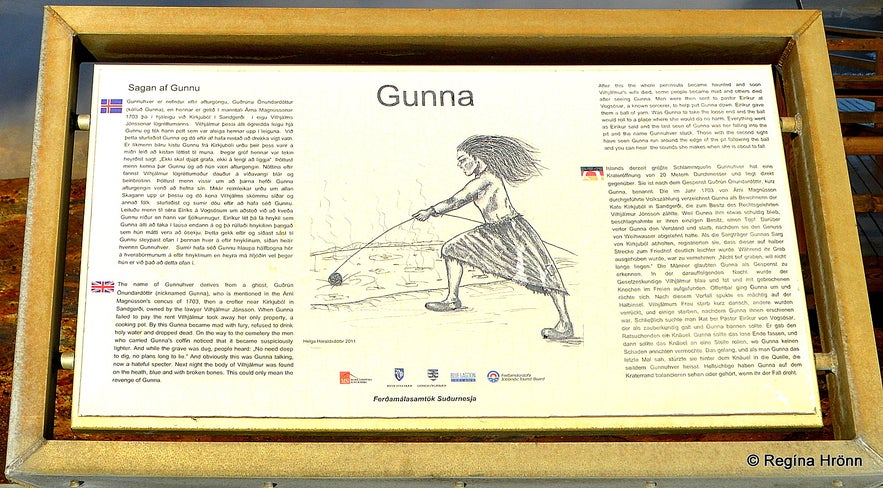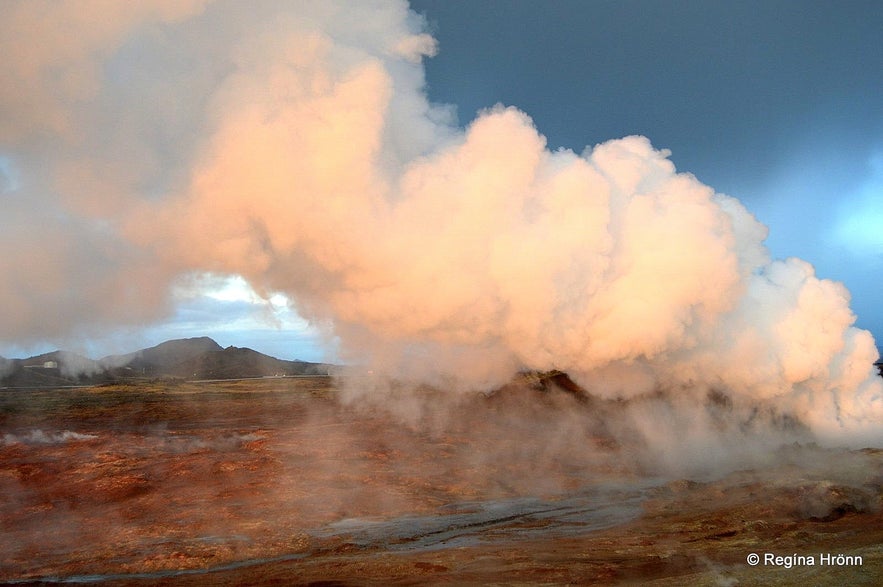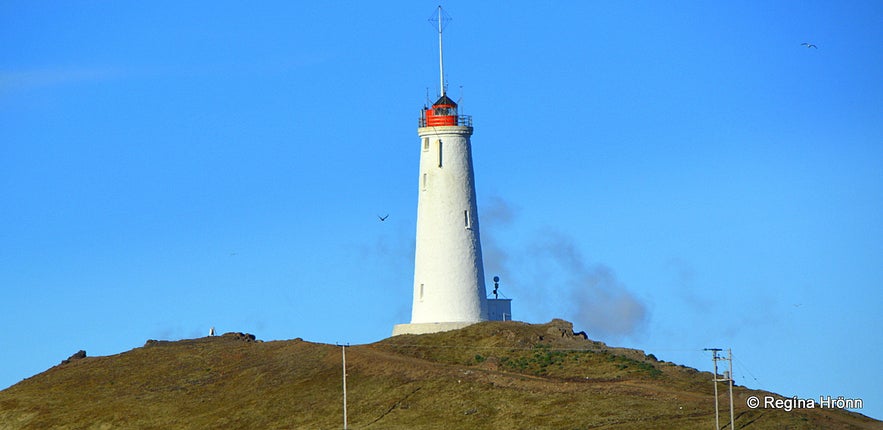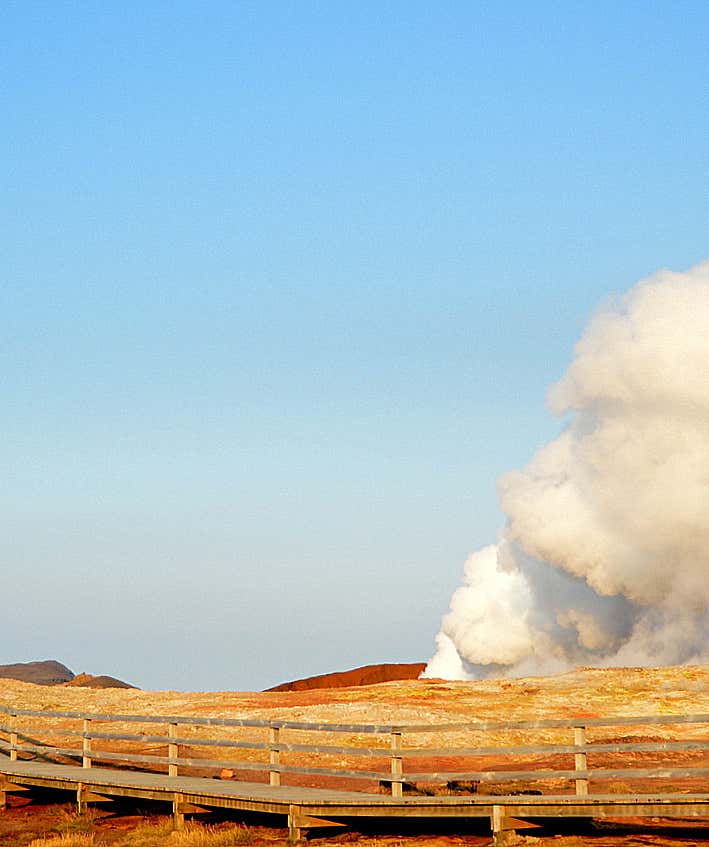
Have you met the angry Ghost at Gunnuhver Mud Pool in Reykjanes in SW-Iceland?

In my last travel-blog, I told you about the colourful Seltún geothermal area on the Reykjanes peninsula in SW Iceland. There is another very interesting geothermal area on this peninsula that is well worth a visit; Gunnuhver geothermal area (it's named after a ghost!)
Top photo: Gunnuhver
Gunnuhver and the information sign
Gunnuhver is the collective name for this geothermal area, named after the angry female ghost Guðrún, or 'Gunna' for short. Here, you will find fumaroles, steam vents, and mud pools and will even risk getting lost amidst the steam. This can make visiting Gunnihver quite unnerving, if not supernatural.
At the Gunnuhver geothermal area, you will find Iceland's largest mud pool, as well as wooden paths and railings with viewing platforms. The large mud pool is located high up in the geothermal area and measures an incredible 20 meters across.
Let's not forget that geothermal areas are dangerous areas, so let's be cautious while visiting them and always stick to the paths.
Gunnuhver and the old observation platform
The activity of this geothermal area changes from time to time (I remember back in 2008 how it increased to a great extent). Hot clay was shot 2-4 metres into the air, steam vents opened and steam started streaming from the area, even drifting across the road; proof of the dangers of geothermal energy!
Gunnuhver geothermal area was closed off for some 2 years during this increased activity and was opened again for visits in 2010. Some might say that it looks as though Gunna the Ghost is trying to escape.
During this period, the observation platform by Gunnuhver, where one could peek into the massive mud pool, crumbled! You can now see the remains of the platform by the hot spring, looking like debris of some sort.
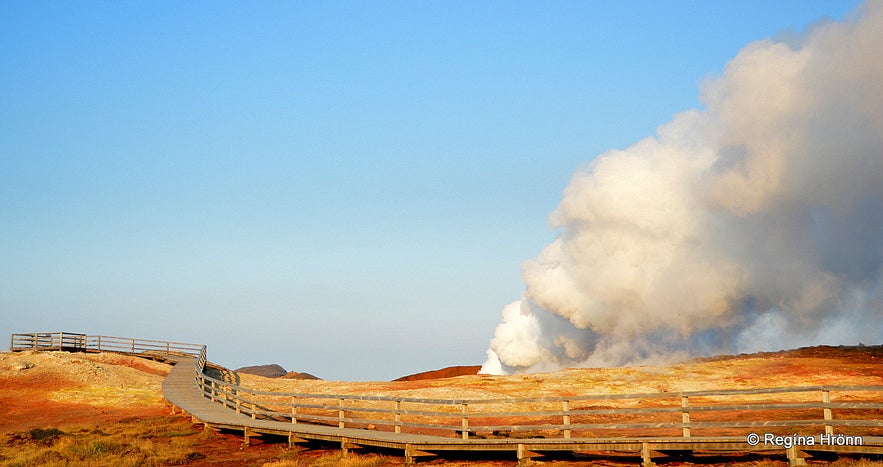
Gunnuhver in 2010
I am often asked the question of why we don't tidy up at Gunnuhver, why we allow debris in this area? Now you know the answer; it is left there as a reminder of what happened back then, and how precarious and ever-changing geothermal areas are.
In September 2014, the mud pool started shooting up hot clay and dirty water from the geothermal area many meters into the sky.
A lot more steam than usual appeared and a new mud pool was created. One of the platforms in the geothermal area had to be closed off again for a short period of time for safety reasons.
Moments before the steam from Gunnuhver engulfed me
Sometimes the steam from Gunnuhver totally engulfs you - my husband took the photo above seconds before I disappeared into the steam.
I am not very keen on being engulfed by the steam, or for turning my back to a massive, thunderous mud pool, for that matter, as you can see from my non-existent smile, but my husband finds it to be hilarious, so I humoured him...
There are many volcanoes on the Reykjanes peninsula and here we find the tectonic plates as well so the earth is known to tremble on this peninsula. In 2021 the earth trembled for 3 weeks making us, the inhabitants of the SW-corner of Iceland, crazy. Then we had a volcanic eruption in Geldingadalir!
 The volcanic eruption in 2021 in Geldingadalir
The volcanic eruption in 2021 in Geldingadalir
I have written a travel-blog about the eruption in Geldingadalir:
The Volcanic Eruption in Geldingadalir Valley on Reykjanesskagi in SW-Iceland
Now, back to Gunnuhver. In 1887 Gunnuhver changed a bit during a series of earthquakes. Again in 1899 Gunnuhver changed during a series of earthquakes and a new fissure opened up.
We have records of a myriad of earthquakes on the Reykjanes peninsula from the year 1151 until today (2021) when the earth has been trembling more than usual.

By Gunnuhver in the evening sun
Now I want to tell you the story of Gunna the Ghost. The folklore of Guðrún (Gunna) is written in Þjóðsögur Jóns Árnasonar - the Collection of Folklore of Jón Árnason, which I often refer to in my travel-blogs:
"Vilhjálmur Jónsson (lögréttumaður) lived at Kirkjuból on the Romshvalanes peninsula; he died in 1706. He had a falling out with a woman called Guðrún Önundardóttir (1646-1706), because of a pot he was supposed to have taken from her, probably as a part of a payment for a debt.
The woman was so upset that she started threatening Vilhjálmur.
The information sign by Gunnuhver tells us about Gunna
Gunna died and, when she was buried, Vilhjálmur was present, but he was on his way through the so-called Skagi, outside of Útskálar (on the Reykjanesskagi peninsula RHR). He went homewards that night but was found dead the day after at Skagi - his body was blue and broken.
His body was brought to the chapel at Kirkjuból and Gísli the minister at Útskálar was asked to stay awake and guard the body that night, as everybody thought that Gunna had killed him and that she was back from the dead.
The minister said that he had a difficult time protecting the body from the broad (Gunna) so she wouldn't pull it from him.
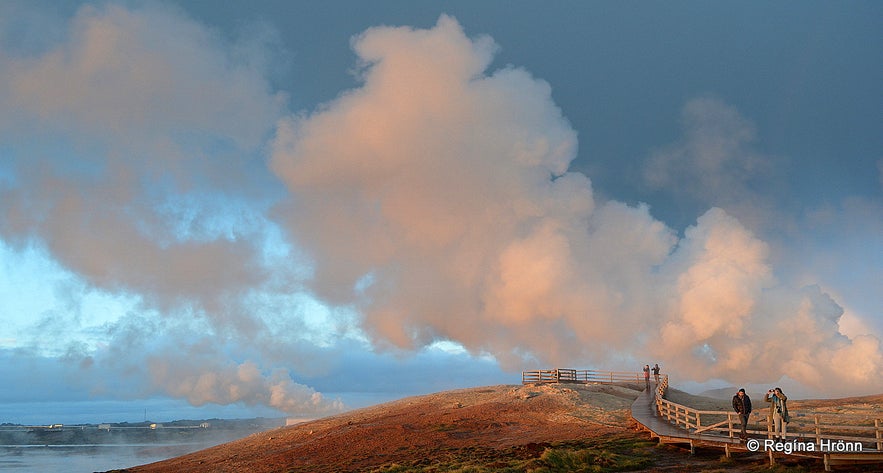
Gunnuhver in the evening sun
The ghost grew stronger and stronger and the widow of Vilhjálmur died suddenly; Gunna was blamed for her death.
Some of the people travelling through Skagi lost their way and others lost their minds. All this was the doing of Guðrún, and people started seeing the ghost with their bare eyes.
Gunna did so much damage that neither men nor animals could pass through.
Gunnuhver in the evening sun
When things had turned this bad and nobody was able to fight the ghost, two men were sent to ask minister Eiríkur (Magnússon) in Vogsósar for help.
But as it was known that the minister wasn't usually obliging in such matters, the men brought some brennivín liquor with them, as it was commonly known that the minister liked his booze.
The men went on their way to meet minister Eiríkur and did everything they had been ordered to do. He greeted them warmly, but, as they were preparing to return back, he gave them a ball of wool and told them to have Gunna grab hold of the loose end. He said that the ball would then roll to the place where Gunna would be allowed to be in peace.
Gunnuhver
The men now returned back home and followed the minister's orders. As soon as Gunna had grabbed the loose end of the ball of wool it started rolling and she followed.
The last that was seen of the ball of wool and Gunna was that they plunged into the mud pool in Reykjanes in South Iceland, which after this incident was called Gunnuhver hot spring.
Since then nobody has been hurt by the ghost of Gunna.
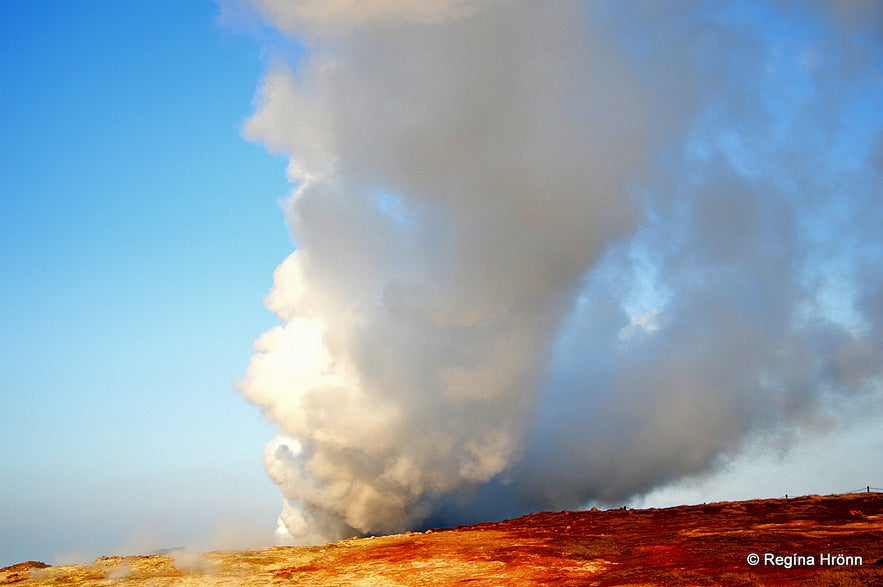
Gunnuhver and the massive steam
Some say that the ball of wool fell into the mud pool, but that Gunna held onto the end; the end is so long that Gunna stands half-bent up on the edge of the mud pool. She patters on the edge, as she does not want to fall into this slough".
(Translated into English from Þjóðsögur Jóns Árnasonar - RHR)
Gunna's story is told a bit differently on the information sign at the geothermal area, but my account is a direct translation of the folklore of Gunnuhver.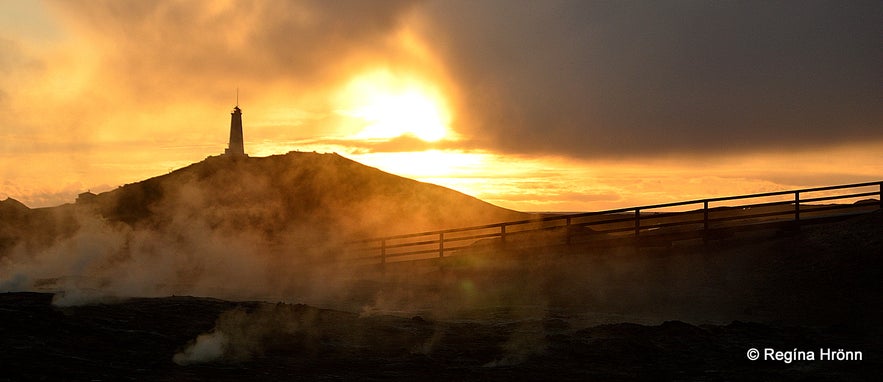
Reykjanesviti lighthouse as seen from Gunnuhver - you can see how close they are one to another
What makes the Gunnuhver geothermal area extra special, apart from being the location of Iceland's largest mud pool and Gunna the ghost, is that the water here is mixed with seawater.
There is much more to see and do in the vicinity of Gunnuhver. From the geothermal area, you will see the lighthouse, Reykjanesviti, standing tall on a hill
Reykjanesviti lighthouse
Reykjanesviti is Iceland's oldest lighthouse, built in 1907-1908, and in 1929 changes were added to it.
An older lighthouse at Valahnúkur (1878), was Iceland's first lighthouse. Due to earthquakes and sea erosion, a new lighthouse was built on the hill.
And by the shore, you will see the distinctive rock formations at Reykjanestá, which is one of the many popular stops on the Reykjanes peninsula.
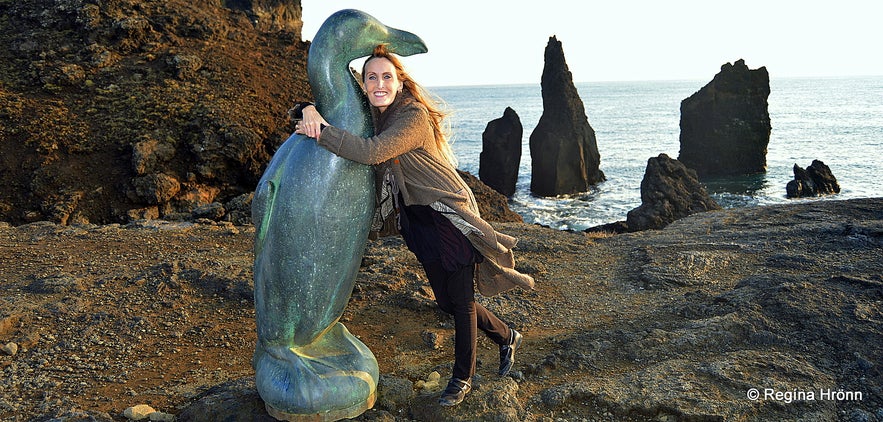
The great auk statue
By the rock formations, you will notice a big bronze statue of the extinct great auk (geirfugl). It was erected in the memory of the last 2 great auks, which were killed on the 3rd of June 1844 by Eldey island, which can be seen in the distance from the shore.
Eldey island is known for having one of the largest nesting sites of gannets in the world, with 14.-18.000 couples of gannets every year visiting the island.
The statue is a part of the Last Bird Project by the artist Todd McGrain and stands here on this spot as a reminder to us human beings to never kill animals to their extinction.
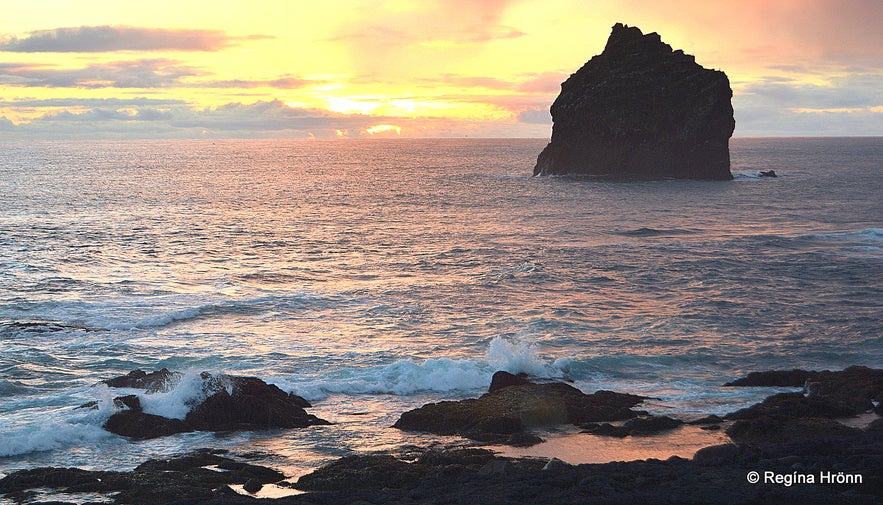
Karlinn in the evening sun
In my photo above you see the rock Karlinn (the Man) or the Troll in the evening sun.
Karlinn is an eroded volcanic plug some 50-60 m high. Usually, folklore is connected to such cliffs and where there is a Karl there is usually a Kerling or a Troll woman, who is his partner.
I have written many travel-blogs about such rocks, f.ex. Kerlingarskarð Pass in Snæfellsnes in West-Iceland - the Folklore of the Giantess & her Fiancé
The exhibition Power Plant Earth
Next to the Gunnuhver geothermal area, you will see the colourful geothermal Kísilhóll hill.
Behind Kísilhóll you will find Reykjanesvirkjun - Reykjanes Geothermal Power Plant, where you can pop in for a visit to the interactive exhibition Power Plant Earth.
I have visited this exhibition and can recommend it - it is very informative.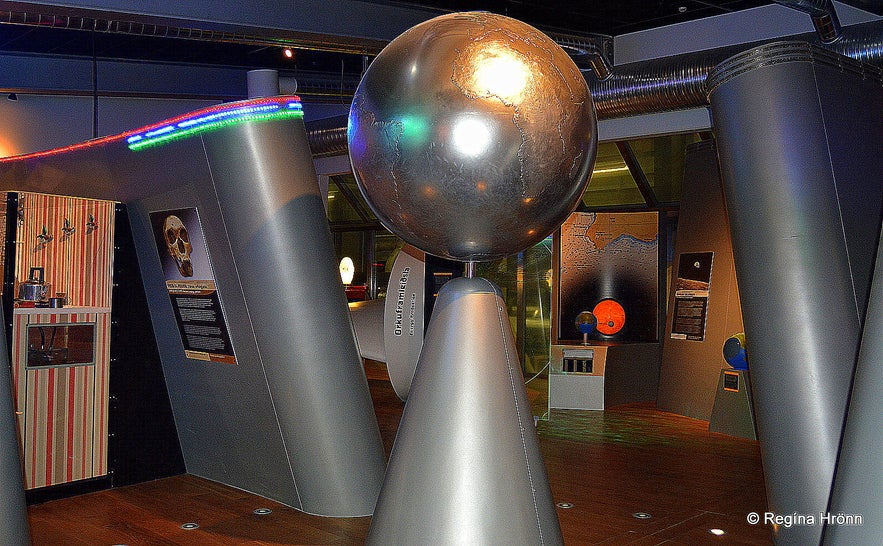
The exhibition Power Plant Earth
Gunnuhver is located some 80 km away from Reykjavík. To visit this area you can either book a Reykjanes tour or rent a car in Reykjavík and visit it on your own.
Visiting the Reykjanes peninsula makes for a lovely day tour with a relaxing soak in the Blue Lagoon at the end of the day before returning back to Reykjavík.
See also:
A Local's Experience of the Blue Lagoon in Iceland

Relaxing in the Blue lagoon
The circle around the Reykjanes peninsula is called the Blue Diamond Circle named after the Blue lagoon, but we have several jewel circles in Iceland:
The Golden Circle - Iceland's most popular route
The Silver Circle of West Iceland
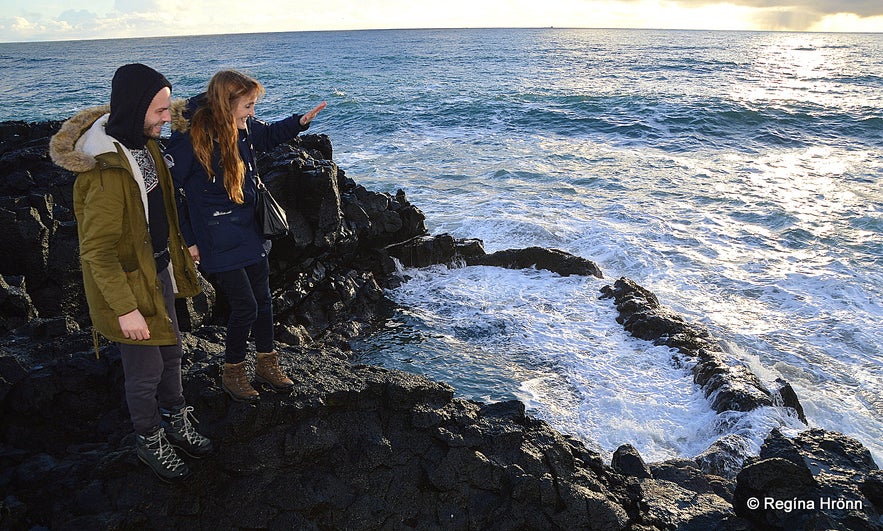
By Brimketill - the waves were so tall that they almost caught us!
Reykjanes is a UNESCO Global Geo Park and there are many more sights, like Brimketill and the Bridge between Continents, where you can see the tectonic plates above ground.
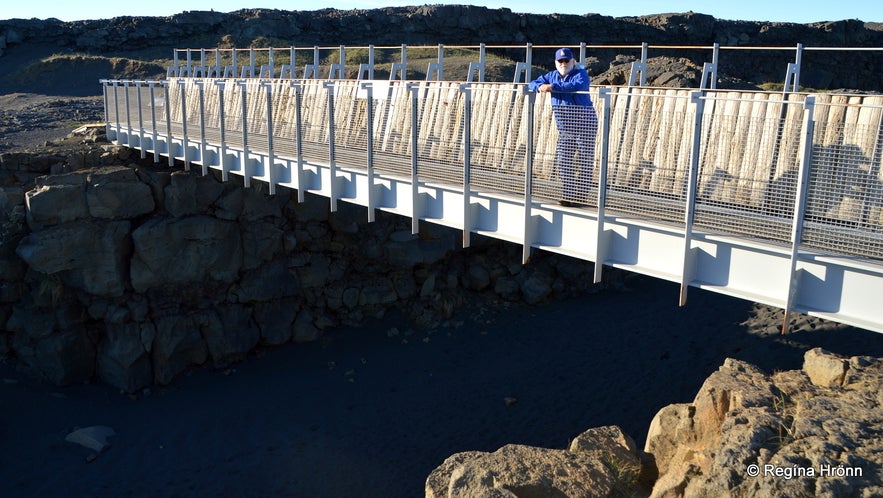
Brúin milli heimsálfa - the Bridge between Continents - my friend Óli the guide on the bridge
By now I have shown you a couple of the many interesting sights on the volcanic Reykjanes peninsula:
Seltún - the colourful Geothermal Area at Krýsuvík on the Reykjanes Peninsula in SW-Iceland
The gentle Giantess in the Cave in Keflavík Town in SW-Iceland
The amazing Lambafellsklofi Rift on the Reykjanesskagi Peninsula in South-West Iceland
The Volcanic Eruption in Geldingadalir Valley on Reykjanesskagi in SW-Iceland
Beautiful sunset at Eldvörp Row of Craters on the Reykjanes Peninsula in SW-Iceland
Have a lovely time at Gunnuhver geothermal area and the Reykjanes peninsula :)
Читать другие блоги
Загадка отеля Radisson 1919
Из истории славного города Рейкьявика Каждый умный человек знает, что свастика, как древний положительный символ движения, благоденствия, солнцеворота, не имеет ничего общего с преступным нацистскимЧитать далееАвтобусы в Рейкьявике и Исландии
Привет, ребята Сейчас очень быстро, без лирических отступлений, расскажу вам об общественном транспорте Рейкьявика - автобусах Stræto. Эти знания вам очень пригодятся, если, приехав в Рейкьявик, выЧитать далееКак Исландия вдохновила легендарных рокеров
Рассказ о том, как песня об Исландии стала классикой рока. Я очень люблю музыку. А музыка - это одна из причин, почему я люблю Исландию. Но история эта не про исландскую группу, а про легенд рок-нЧитать далее

Загрузите приложение крупнейшего туристического портала Исландии на свой телефон, чтобы управлять всей поездкой в одном месте.
Отсканируйте этот QR-код с помощью камеры телефона и нажмите на появившуюся ссылку, чтобы всегда иметь доступ к крупнейшему туристическому порталу Исландии в своем кармане. Введите свой номер телефона или адрес электронной почты, чтобы получить SMS или электронное письмо со ссылкой на скачивание.

